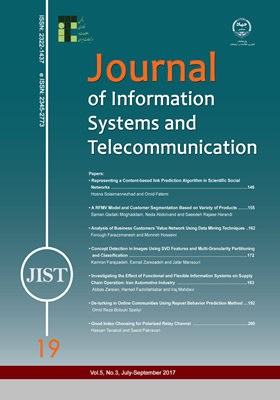-
-
List of Articles
-
Open Access Article
1 - Improving Image Dynamic Range For An Adaptive Quality Enhancement Using Gamma Correction
Hamid Hassanpour -
Open Access Article
2 - Representing a Content-based link Prediction Algorithm in Scientific Social Networks
Hosna Solaimannezhad omid fatemi -
Open Access Article
3 - Investigating the Effect of Functional and Flexible Information Systems on Supply Chain Operation: Iran Automotive Industry
Abbas Zareian Iraj Mahdavi Hamed Fazlollahtabar -
Open Access Article
4 - Analysis of Business Customers’ Value Network Using Data Mining Techniques
Forough Farazzmanesh (Isvand) Monireh Hosseini -
Open Access Article
5 - De-lurking in Online Communities Using Repost Behavior Prediction Method
Omid Reza Bolouki Speily -
Open Access Article
6 - Concept Detection in Images Using SVD Features and Multi-Granularity Partitioning and Classification
Kamran Farajzadeh Esmail Zarezadeh Jafar Mansouri -
Open Access Article
7 - Good Index Choosing for Polarized Relay Channel
Hassan Tavakoli Saeid Pakravan -
Open Access Article
8 - A RFMV Model and Customer Segmentation Based on Variety of Products
Saman Qadaki Moghaddam Neda Abdolvand Saeedeh Rajaee Harandi
-
The rights to this website are owned by the Raimag Press Management System.
Copyright © 2017-2025







